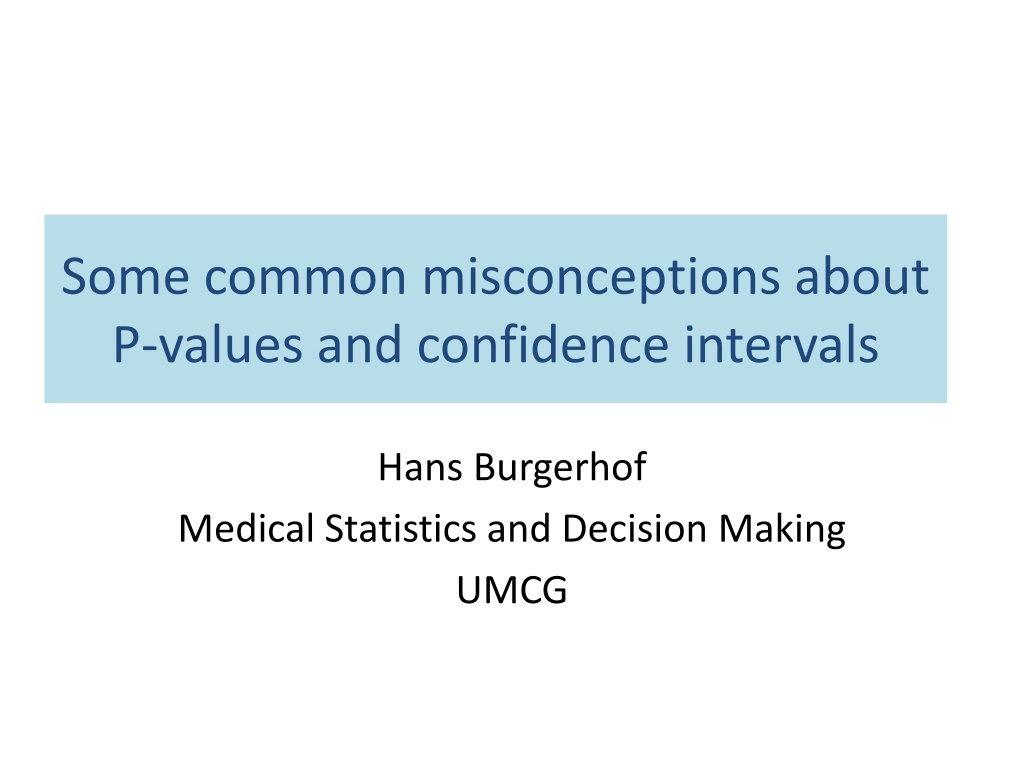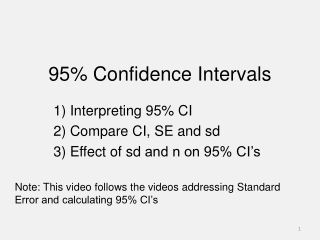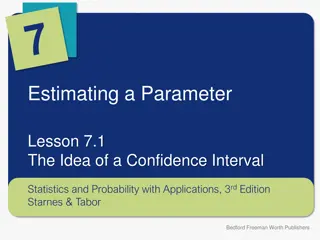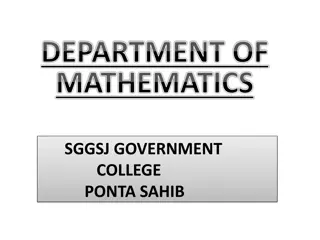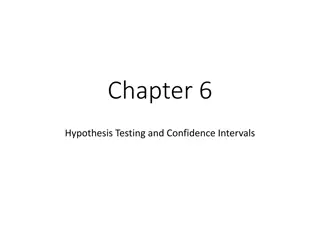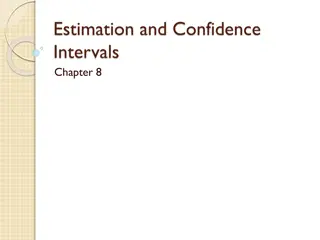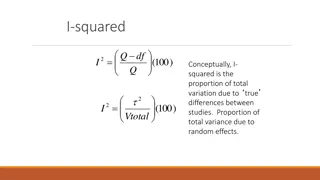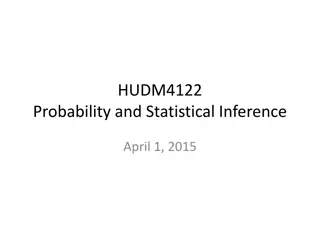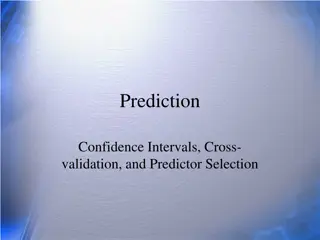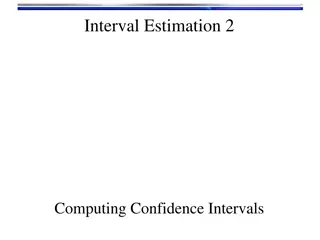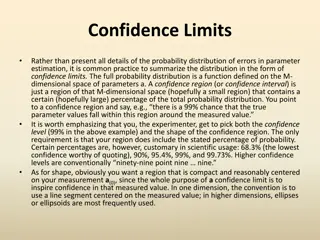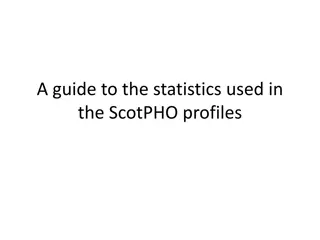Understanding Common Misconceptions About P-Values and Confidence Intervals in Statistics
Explore common misconceptions surrounding P-values and confidence intervals in statistical analysis through lunchtime lectures at UMCG. Gain insights on theory, frequentist statistics, and deciphering statements about statistical methods. Challenge your understanding with true/false statements and delve into testing hypotheses.
Download Presentation

Please find below an Image/Link to download the presentation.
The content on the website is provided AS IS for your information and personal use only. It may not be sold, licensed, or shared on other websites without obtaining consent from the author. Download presentation by click this link. If you encounter any issues during the download, it is possible that the publisher has removed the file from their server.
E N D
Presentation Transcript
Some common misconceptions about P-values and confidence intervals Hans Burgerhof Medical Statistics and Decision Making UMCG
Help! Statistics! Lunchtime Lectures What? frequently used statistical methods and questions in a manageable timeframe for all researchers at the UMCG No knowledge of advanced statistics is required. When? Lectures take place every 2ndTuesday of the month, 12.00-13.00 hrs. Who? Unit for Medical Statistics and Decision Making When? Where? What? Who? Feb 14, 2017 3212.0217 Some common misconceptions about p- values and confidence intervals H. Burgerhof Mar 14, 2017 Apr 11, 2017 May 9, 2017 Room 16 Rode Zaal Rode Zaal Mediation analysis Basics of survival analysis Multiple linear regression; some do s and don ts Multiple testing S. la Bastide D. Postmus H. Burgerhof June 13, 2017 Room 16 C. zu Eulenburg 2 Slides can be downloaded from http://www.rug.nl/research/epidemiology/download-area
Some publications It is true! 6358235333419573281092854367_donald-trump Article in NRC (Dutch newspaper) June 18th 2016 De val van het P-getal ( The fall of the P-value )
Program Some statements: true or false? Theory of Frequentist Statistics Confidende Intervals P-values Correct answers to the statements One of the most prevalent misconceptions about Confidence Intervals revisited A new horizon? Afbeeldingsresultaat voor zonsopgang tekening
Statements, true or false? 1. The P-value is the probability that the null hypothesis is true 2. A P-value larger than 0.05 proves the null hypothesis to be true 3. A P-value smaller than 0.05 tells us we found a clinically relevant difference 4. A two-sided P-value always equals twice the one- sided P-value 5. Statement 4 is true if the underlying distribution is symmetric
Statements, true or false? (continued) 6. In case of a one sample t-test, the following equivalence relation holds: the 95% CI contains the value of the null hypothesis the two-sided P-value > 0.05 7. Statement 6 holds for any statistical test 8. If the 95% CI s concerning two means overlap, the difference between the two means is not significant (using an alpha = 0.05)
Testing H0: = 96 against H1: > 96 Distribution of the sample mean if H0 is true Significance level H0 : = 96 If ? is in this part, we will not reject H0 If ? is in this part, we will reject H0
Significance level (most common value 0.05) H0: = 96 H1: > 96 H0: = 96 H1: 96 (one-sided alternative) (two-sided alternative) = 0.05 0.025 0.025 H0 : = 96 H0 : = 96 = 0.05 We will reject the null hypothesis if the sample mean is in the rejection area or, equivalently, if P . The P-value is a conditional probability.
Statements, true or false? 1. The P-value is the probability that the null hypothesis is true 2. A P-value larger than 0.05 proves the null hypothesis to be true 3. A P-value smaller than 0.05 tells us we found a clinically relevant difference 4. A two-sided P-value always equals twice the one- sided P-value 5. Statement 4 is true if the underlying distribution is symmetric FALSE FALSE FALSE FALSE FALSE
Testing H0: = 0.3. n = 50, k = 23 0,12 0,10 0,08 Value p 0,06 23 0,04 0,02 0,00 1 2 3 4 5 6 7 8 9 1 0 1 1 1 2 1 3 1 4 1 5 1 6 1 7 1 8 1 9 2 0 2 1 2 2 2 3 2 4 2 5 2 6 2 7 2 8 2 9 3 0 3 1 3 2 3 3 3 4 3 5 3 6 3 7 3 8 3 9 4 0 4 1 4 2 4 3 4 4 4 5 4 6 4 7 4 8 4 9 5 0 15 aantal One-sided P-value: P(X 23) = 0.0123 Two-sided P-value: P(X 23) + P(X 7) = 0.0196
Two sided test, mean SBP smokers = mean SBP non-smokers = 0 0 H0: NS S reject H0if z (or t) H1: NS S is too small or too high Say z = 1.56 than the two sided P = 0.12 Two sided P = 0.12 ??? ?? ?? ? =
One sided test (1) reject H0if z (or t) is too high = 0 0 H0: NS S We are only interested in H1: NS S the probability on the right hand side The result is in the direction of H1 One sided P = 0.06 P(one sided) = P(two sided) ??? ?? ?? ? =
One sided test (2) = 0 0 H0: NS S reject H0if z (or t) is too small H1: NS S We are interested in the probability on the left hand side One sided P = 0.94 The result is not in the direction of H1 P(one sided) = 1- P(two sided)
Confidence Interval (for ) X1 = 99 0.30 X2 = 104 0.25 0.20 y 0.15 . 0.10 0.05 Xn = 97 0.00 92 94 96 98 100 = ? ... X x . 1 . 1 + = . 1 . 1 + [ 96 ; 96 ] [ 96 ; n 96 ] X SE X SE X X n s s + unknown is or [ ; n if ] X t X t n
Interpretation of 95%-CI for Imagine you will take thousands of samples and for each sample you will calculate the 95% CI 95% of these intervals will contain the population mean . Sample number
Statements, true or false? (continued) 6. In case of a one sample t-test, the following equivalence relation holds: the 95% CI contains the value of the null hypothesis the two-sided P-value > 0.05 7. Statement 6 holds for any statistical test 8. If the 95% CI s concerning two means overlap, the difference between the two means is not significant (using an alpha = 0.05) TRUE FALSE FALSE
8. What can happen ?1 ?2 100 2*3 = [ 94 ; 106 ] 112 2*4 = [ 104 ; 120 ] 112 100 2*5 = [ 2 ; 22 ] ?2 ?1 0 2 ??12+ ??2 ?? ?????????? =
Hoekstra et al: Robust misinterpretation of CIs (Psychonomic Bulletin & Review, 2014) Given: 95% CI = [ 0.1 ; 0.4]
Back to basics Jerzy Neyman wrote in 1937: Outline of a theory of statistical estimation based on the clasical theory of probability. As soon as the Confidence Interval has been calculated (e.g. [ 0.1 ; 0.4]), frequentists cannot do any probability statements. The unknown (and fixed) parameter is either in the interval or not. Afbeeldingsresultaat voor einstein That holds for any interval !
What to do? Bayesian statisticians do make probability statements about population parameters (future lunch lecture?) Option for Liberal Frequentist Statistics? P(new colleague has his birth day in April)? For me, under certain assumptions (not born in a leap-year, all days same probability), P = 30/365 For him: P is either 0 or 1.
Living in ignorance As long as I do not know my new colleague s birthday, my probability is still 30/365. As long as I do not know the real population mean, I am 95% confident that my confidence interval contains Being confident is not a mathematically defined concept (yet ) FALSE ?
Liberal Frequentist definition of being confident I solemnly swear that I do know that, in the context of Frequentist Statistics, the parameters I estimate have fixed values and by no means are random variables. Lower limits and upper limits, calculated according to Jerzy Neyman s 1937 paper, will give me x% Confidence Intervals, one for each parameter. X% of these intervals will contain the real and unknown values of my parameters. For each of the random intervals there is probability equal to x/100 of containing the real and unknown parameter. As long as I do not know the real value of a specific parameter, I am x% confident that the calculated interval for this parameter contains the real, fixed, value.
By the way, I asked my new colleague Say Willy, what s your birth day? Afbeeldingsresultaat voor hans burgerhof April 27, why? Afbeeldingsresultaat voor willem alexander
Next Lunchtime Lecture of Help! Statistics! March 14, 2017 Room 16 UMCG Sacha la Bastide Mediation analysis Any questions?
